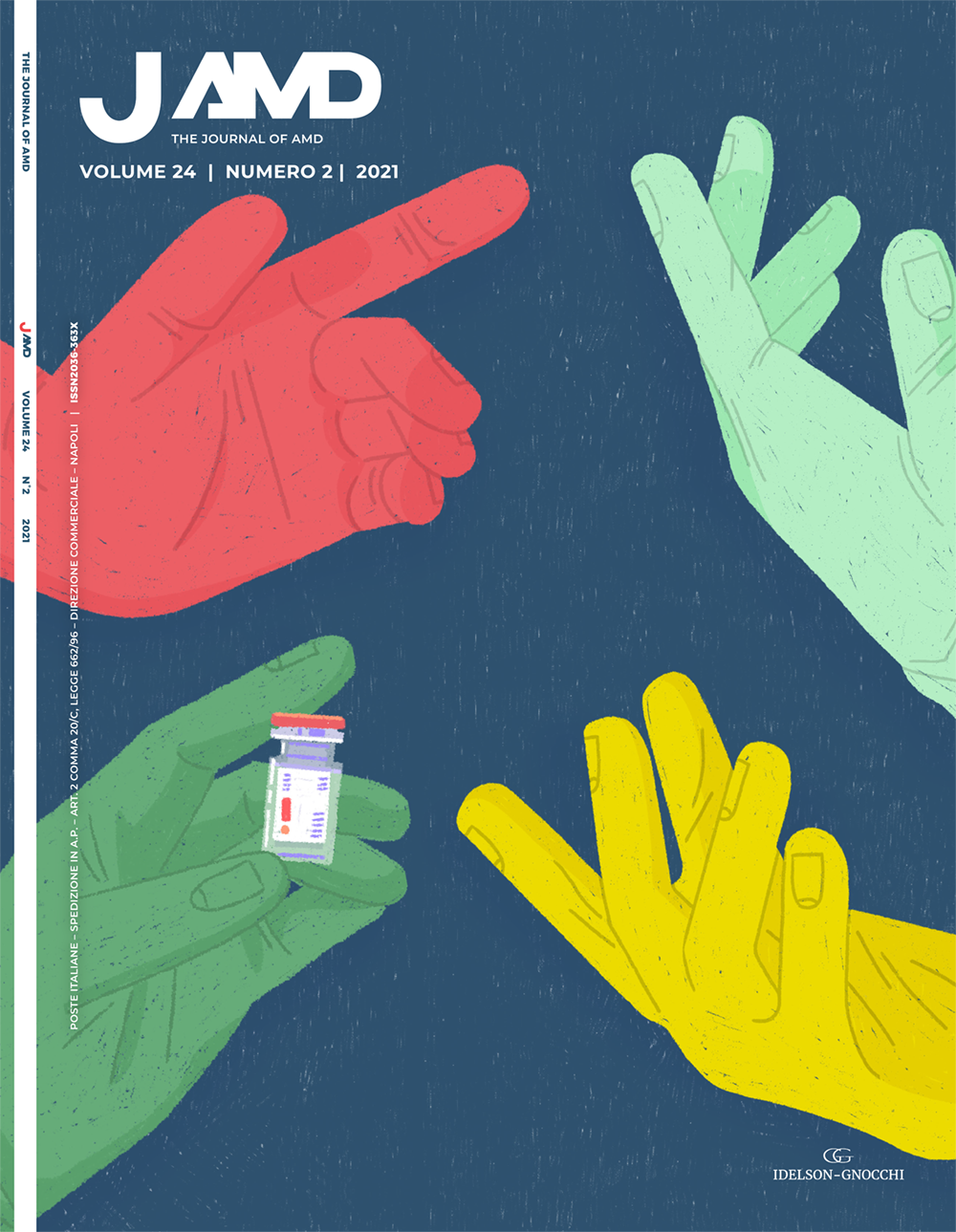Original articles
New horizons for insulin therapy with a pump: the artificial pancreas
JAMD 2021;24(2):86-96
The monitoring and treatment of type 1 diabetes (T1D) are undergoing profound changes today. Notable steps include the improvement and widespread adoption of glucose sensors which are now extremely reliable and furthermore are used with insulin pumps in an integrated manner. Over the last 2 to 3 years these systems have evolved rapidly with the development and use of algorithms which permit the autonomous regulation of basal insulin. Correct control and administration of basal insulin is often the greatest stumbling block in multiple daily injection therapy as basal insulins cannot replicate the physiological rhythms of basal insulin secretion. Hypoglycemia is another critical point in standard insulin pen therapy as it does not permit dosage modulation in the same way as with an insulin pump. In this article we cover the fundamental steps in this revolution of insulin therapy which promises, in the not too distant future, the ultimate achievement of the artificial pancreas and thus the complete closure of the loop. All those working in diabetes care must be adequately trained and familiar with this technology as it should no longer be considered a niche treatment reserved for carefully selected patients and managed in only a few centers of excellence. In order to choose the best treatment, tailored to each individual patient’s needs, medical staff involved in the treatment of T1D require a thorough knowledge of standalone glucose sensors, insulin pumps and integrated systems with control algorithms.Once the critical issues (costs, psychological aspects, system management difficulties, alarm fatigue, etc.) still related to their use have been resolved, new Hybrid Closed Loop and Advanced Hybrid Closed Loop systems could become the new standard in the treatment of T1D.
KEYWORDS type 1 Diabetes; insulin pump; decision-making algorithms; integrated system.
Diabetes management in telemedicine: patients’ opinion (preliminary data)
JAMD 2021;24(2):97-104
With the outbreak of the COVID-19 pandemic and the resulting restrictions, telemedicine has enabled healthcare to be provided to patients with chronic diseases, although with some restrictions. During the lockdown The Campania region was the first to order (03/27/2020), to protect the health of citizens suffering from diabetes mellitus, the use of telemedicine and a tele-health service was activated in our clinics.
At the end of the consultation, a survey was submitted to our diabetic patients in order to evaluate their opinion about the telemedicine experience in comparison with the traditional clinic visit.
100% of both type 1 and type 2 patients consider the telemedicine visit adequate, 89.2% of types 1 and 75.9% of types 2 consider the two forms of visit absolutely overlapping from a professional point of view, and even 6.9% of type 2, but none of type 1, considers the tele-visit more effective than the traditional visit. However, only 44.8% (type 2 diabetic patients) and 13,5%% (type 1 diabetic patients) expressed a preference for telemedicine visits over traditional visits. Telemedicine has allowed continuity of care for diabetic patients despite the difficulties of this emergency time. We believe that the opinion of patients and health care professionals on the telemedicine experience can be useful to assess the limitations and advantages in order to improve and enhance the use of this method.
KEYWORDS diabetes mellitus; telemedicine system; survey.
Reviews
GLP-1 receptor agonists: evolution and advancement in the treatment of type 2 diabetes mellitus
JAMD 2021;24(2):105-115
Type 2 diabetes mellitus is a progressive disease, associated with multiple cardiovascular risk factors (obesity, hypertension, dyslipidemia) and with the development of micro- and macro-vascular complications. Several anti-diabetic drugs commonly used, such as sulfonylureas, thiazolidinediones and insulin induce weight gain and have modest or negative effects on cardiovascular risk factors and cardiovascular events. In this context, the GLP-1 receptor agonists (GLP-1 RA) instead have an important action on glycemic control and β-cell dysfunction, show favorable effects on body weight, hypertension and lipid profile, have a reduced risk of hypoglycemia and more recently have demonstrated clear benefits on major cardiovascular events, cardiovascular mortality and renal damage. In these years it has been an evolution on the role of the GLP-1 RA in the new paradigm of type 2 diabetes. For this reason the GLP-1 RA find place at any moment of the cardiovascular and renal continuum, from the initial one for controlling blood glucose and the different risk factors to the most advanced when cardiovascular damage is already present. The GLP-1 RA therefore represent a key elements in the management of patients with type 2 diabetes at any time in the natural history of the disease both for glycemic control and for the prevention of CV and renal events.
KEYWORDS GLP-1 receptor agonists; type 2 diabetes; cardiovascular risk factors; cardiovascular disease; cardiovascular outcome trials.
Simposio
Risk of infection in diabetes before and during COVID-19: a review
JAMD 2021;24(2):116-121
The risk of almost all types of infection is increased both in type 1 and type 2 diabetic patients. Notably, infections are one of the most important cause of hospitalization and death in diabetes and the risk is increased in patients with poor glycemic control. SARS-CoV2 pandemic stressed this association, since diabetic patients showed a particularly high risk of worse outcomes. This review analyzes the association of diabetes and different infections, underlining how the risk of worse outcomes was present both before and during SARS-CoV2 pandemic.
KEYWORDS COVID-19; infection; diabetes; immunology; susceptibility.
History of vaccines: the prequel to Edward Jenner
JAMD 2021;24(2):122-131
In times of pandemics, it is inevitable for dissertations to revolve around epidemics and that cost efficient cure that can save most lives. Much has already been written about vaccines and much more will be published in the future. When tracing the history of vaccines, authors often begin with the Jenner’s revolutionary technique, and follow its evolution up to the present day. But one’s technique or discovery, however ingenious and innovative, does not originate from thin air. Since the dawn of days, the genus Homo had to deal with infectious and non-comunicable diseases, trying to tackle
them with the cultural means that were available at any given time. “Producing the first vaccine was therefore a long and fascinating adventure of human ingenuity”1. I want then to retrace this path with what archeology, molecular biology, literature and history have to offer, placing Edward Jenner’s work as the culmination of our journey
KEYWORDS history of medicine; epidemics; vaccines.
Current recommended immunizations for patients with diabetes
JAMD 2021;24(2):132-136
Diabetes mellitus is associated with an increased susceptibility towards infectious diseases, with a more severe course of these diseases and with an increased risk of hospitalization and death. For these reasons all vaccinations are strongly recommended in diabetic people. In this paper, after a quick review of the main pathophysiological mechanisms underlying the increased risk of infectious pathology in the diabetic patient, the main recommendations of the current guidelines on vaccination in diabetic patients will be reviewed.
KEYWORDS vaccination; guidelines; influenza virus; Herpes Zoster.
Vaccines against SARS CoV 2 and the vaccination campaign in Italy
JAMD 2021;24(2):137-142
The SARS COV 2 pandemic has created an unprecedented need to manufacture and distribute a safe and effective vaccine to immunize an exceptionally large number of individuals planning diversified vaccination approaches quickly. A few weeks have passed since the sequencing of the viral genome for the design of the first vaccines and a few months for the implementation of the efficacy and safety studies. The article analyzes the types of vaccines available by examining their characteristics, efficacy and safety, also examining some debated issues such as the thrombotic risk of viral vector vaccines. The second part deals with the issue of the vaccination campaign in our country.
KEYWORDS vaccination; COVID-19; spike protein; efficacy; safety.
Vaccination in special populations: pregnancy and patients with cancer
JAMD 2021;24(2):143-151
The current COVID-19 pandemic and the strategies implemented for tackling its spread have highlighted the importance of vaccination strategies for immunization from communicable diseases. Vaccinations are one of the most effective preventive tools in Public Health, being able to effectively and safely prevent the development of some infectious diseases, their complications, and their spread. Compared to the general population, there are groups of individuals who present a specific risk of contracting particular infections or developing more serious consequences. The purpose of this brief review is to describe the vaccination strategies currently recommended for pregnant women and cancer patients, paying particular attention to subjects simultaneously suffering from diabetes and providing some specific information on COVID-19 vaccination. The knowledge of this constantly evolving issue, also in relation to special populations such as pregnant or lactating women and cancer patients, allows Diabetologists to safeguard the undisputed health and social value of this fundamental preventive strategy.
KEYWORDS diabetes mellitus; pregnancy; cancer; vaccination; COVID-19.
The vaccination rules. A personal comment
JAMD 2021;24(2):152-153
Position Statement
Guidance for the management of inpatient hyperglycemia in COVID-19
JAMD 2021;24(2):154-163
Diabetes and hyperglycemia are among the most common problems in hospitalized patients, a combination particularly evident in patients affected by COVID-19. Therefore the management of these, already complex, patients becomes critical. SARS-CoV2 infection increases insulin resistance and alters its production by pancreatic beta-cells, therefore severe hyperglycemia is frequent in patients admitted to COVID hospitals both already suffering from Diabetes mellitus or dysglycemia, and in those without known alterations of glucose metabolism. High-dose glucocorticoid treatment, frequently used in more complex COVID-19, also alters glucose metabolism, thus worsening hyperglycemia. Consequently, severe hyperglycemia is frequent, both in the admission phase and during hospitalization of COVID-19 in patients, and therefore, although the care and assistance of COVID-19 inpatients is complex, treatment of hyperglycemia cannot be underestimated. It has indeed been demonstrated that glucose levels above 180 mg/dL are known to be linked to increased mortality and worse prognosis of inpatients. In addition, people with diabetes are at a higher risk of serious COVID-19. The aim of this work was to offer to healthcare professionals involved in the care of COVID inpatients a support in making clinical decisions for the management of hyperglycemia, so to ensure both appropriate blood glucose surveillance and hyperglycemia management avoiding improper use of precious resources. Therefore, the Inpatient project group has developed easy-to-consult flow charts available on the AMD website during the COVID-19 pandemic second wave.
KEYWORDS management of hyperglycemic crises; inpatients with COVID-19; glucocorticosteroid therapy.
Attività dei gruppi
Gruppo Medicina di Genere – Gender Medicine Workgroup
Risposta farmacologica ai farmaci basata su sesso e genere
JAMD 2021;24(2):164-167
Differenze di genere nella valutazione dei fattori di rischio cardiovascolare e nello screening delle complicanze croniche nei soggetti con diabete: una revisione sistematica della letteratura
JAMD 2021;24(2):168-170




